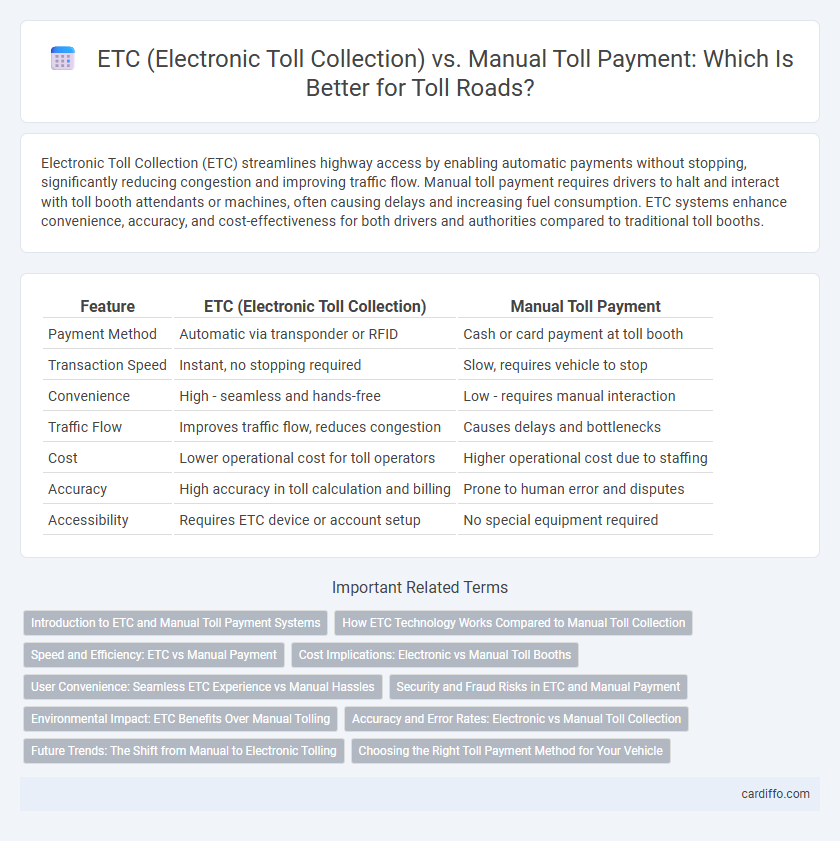Electronic Toll Collection (ETC) streamlines highway access by enabling automatic payments without stopping, significantly reducing congestion and improving traffic flow. Manual toll payment requires drivers to halt and interact with toll booth attendants or machines, often causing delays and increasing fuel consumption. ETC systems enhance convenience, accuracy, and cost-effectiveness for both drivers and authorities compared to traditional toll booths.
Table of Comparison
| Feature | ETC (Electronic Toll Collection) | Manual Toll Payment |
|---|---|---|
| Payment Method | Automatic via transponder or RFID | Cash or card payment at toll booth |
| Transaction Speed | Instant, no stopping required | Slow, requires vehicle to stop |
| Convenience | High - seamless and hands-free | Low - requires manual interaction |
| Traffic Flow | Improves traffic flow, reduces congestion | Causes delays and bottlenecks |
| Cost | Lower operational cost for toll operators | Higher operational cost due to staffing |
| Accuracy | High accuracy in toll calculation and billing | Prone to human error and disputes |
| Accessibility | Requires ETC device or account setup | No special equipment required |
Introduction to ETC and Manual Toll Payment Systems
Electronic Toll Collection (ETC) systems enable vehicles to pass through toll points without stopping by using RFID tags or transponders for automatic payment, significantly reducing traffic congestion and improving flow efficiency. Manual toll payment requires drivers to stop and pay toll operators or use cash machines, leading to increased wait times and higher operational costs. ETC technology enhances user convenience while decreasing toll plaza staffing needs and minimizing human error in transaction processing.
How ETC Technology Works Compared to Manual Toll Collection
ETC (Electronic Toll Collection) utilizes RFID or DSRC technology to automatically identify and charge vehicles as they pass toll points, eliminating the need to stop and manually pay. Sensors detect transponders equipped in vehicles, communicating with a centralized system to debit accounts in real time, boosting traffic flow efficiency and reducing congestion. In contrast, manual toll collection requires physical payment at booths, involving human interaction and longer wait times, leading to slower throughput and increased operational costs.
Speed and Efficiency: ETC vs Manual Payment
ETC (Electronic Toll Collection) significantly outpaces manual toll payment by enabling vehicles to pass through toll booths without stopping, reducing transaction time to mere seconds. This automated system decreases traffic congestion and enhances overall road efficiency by streamlining vehicle flow. Manual toll payment, involving cash or card transactions, causes delays and longer queues, impacting travel speed and increasing fuel consumption.
Cost Implications: Electronic vs Manual Toll Booths
Electronic Toll Collection (ETC) systems significantly reduce operational costs by minimizing the need for toll booth attendants and decreasing cash handling expenses, resulting in lower labor and maintenance costs. Manual toll payment methods incur higher expenses due to staffing requirements, increased transaction times, and cash management complexities, which elevate overall operational costs. Implementing ETC leads to improved cost-efficiency and scalability for toll operators by automating payments and reducing human-related overhead.
User Convenience: Seamless ETC Experience vs Manual Hassles
ETC (Electronic Toll Collection) offers a seamless user experience by enabling automated toll payments without stopping, reducing travel time and avoiding long queues. Manual toll payments involve physical cash or card transactions, causing delays and inconvenience, especially during peak hours. ETC enhances convenience with faster throughput, contactless processing, and real-time account management, making it the preferred choice for frequent highway users.
Security and Fraud Risks in ETC and Manual Payment
Electronic Toll Collection (ETC) systems reduce human error but present security vulnerabilities such as hacking, data breaches, and unauthorized account access, increasing fraud risks including toll evasion and identity theft. Manual toll payments rely on physical cash or card transactions, which can be susceptible to theft, counterfeit currency, and manipulation by toll operators but limit digital hacking threats. Both methods require robust security protocols, with ETC demanding advanced encryption and real-time monitoring to mitigate cyber fraud, while manual payments depend on physical security measures and audit trails to prevent corruption and cash skimming.
Environmental Impact: ETC Benefits Over Manual Tolling
Electronic Toll Collection (ETC) significantly reduces carbon emissions by minimizing vehicle idling and stop-and-go traffic compared to manual toll payment systems. Studies show ETC can lower fuel consumption by up to 15%, directly decreasing air pollution and greenhouse gas output. This streamlined process supports sustainable transportation by reducing congestion-related environmental impacts.
Accuracy and Error Rates: Electronic vs Manual Toll Collection
Electronic Toll Collection (ETC) systems significantly reduce error rates compared to manual toll payment by automating vehicle identification and payment processing, eliminating human input mistakes. Accuracy in ETC is enhanced through real-time data capture and digital validation, ensuring precise toll charges aligned with vehicle classifications and travel distances. Manual toll payments often result in higher error rates due to miscommunication, manual data entry errors, and cash handling issues, leading to discrepancies and revenue loss.
Future Trends: The Shift from Manual to Electronic Tolling
ETC (Electronic Toll Collection) is rapidly replacing manual toll payment systems due to its efficiency, reduced congestion, and enhanced accuracy in toll collection. Future trends indicate widespread adoption of ETC technologies including RFID, GPS-based tolling, and mobile payment integration, transforming traffic management and revenue collection. Advanced data analytics and AI-driven monitoring will further optimize toll operations, minimizing delays and operational costs compared to traditional manual booths.
Choosing the Right Toll Payment Method for Your Vehicle
Electronic Toll Collection (ETC) offers faster, contactless payment ideal for frequent travelers and reduces congestion at toll plazas, while manual toll payment remains suitable for occasional users or those without ETC-compatible vehicles. Vehicle type and travel frequency should influence the choice; heavy commercial trucks benefit significantly from ETC due to consistent route usage and time savings. Consider compatibility with your vehicle's technology and the availability of ETC infrastructure on your regular routes to optimize toll payment efficiency.
ETC (Electronic Toll Collection) vs Manual toll payment Infographic

 cardiffo.com
cardiffo.com